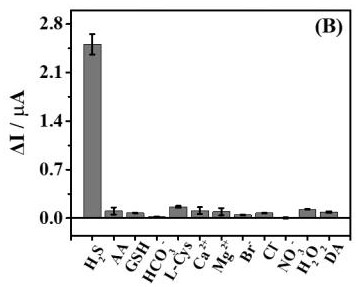A kind of preparation method and application of hydrogen sulfide photoelectrochemical sensor
A photoelectrochemical and hydrogen sulfide technology, applied in the field of analytical chemistry, can solve the problems of sensor stability and reproducibility attenuation, long preparatory work, cumbersome steps, etc., and achieve large band gap, high sensitivity and high selectivity quantification Effects of detection and simplification of assembly
- Summary
- Abstract
- Description
- Claims
- Application Information
AI Technical Summary
Problems solved by technology
Method used
Image
Examples
Embodiment 1
[0035] The preparation of highly sensitive and selective hydrogen sulfide photoelectrochemical sensor, it comprises the steps:
[0036] (1) Weigh an appropriate amount of anhydrous sodium sulfate and prepare it into an aqueous solution of the required concentration.
[0037] (2) Use BR buffer to adjust the pH of the sodium sulfate aqueous solution within the range of pH 2.0-10.0 as needed.
[0038] (3) Take several milliliters of the mixed solution whose pH has been adjusted in (2), and put it in a fully transparent quartz reaction cell.
[0039] (4) The gallium nitride wafer epitaxially grown on the alumina substrate was cut into 5×15 mm wafers, and used as the working electrode, the platinum wire electrode as the counter electrode, and the Ag / AgCl electrode as the reference electrode. Submerge the three-electrode system in the above-mentioned quartz reaction cell filled with the solution.
[0040] (5) Place the reaction system with the electrodes connected in (4) in a dark...
Embodiment 2
[0046] The detection method of hydrogen sulfide concentration in the sample to be tested, it may further comprise the steps:
[0047](1) The gallium nitride wafer epitaxially grown on the alumina substrate was cut into 5×15 mm wafers, and used as the working electrode, the platinum wire electrode as the counter electrode, and the Ag / AgCl electrode as the reference electrode. The three-electrode system was submerged in a quartz reaction cell filled with 0.01 M sodium sulfate aqueous solution.
[0048] (2) Use BR buffer to adjust the solution system in (1) to pH=8.0.
[0049] (3) Add sulfonated iron phthalocyanine (trivalent) with a final concentration of 10 μM and cetyltrimethylammonium bromide dispersant with a final concentration of 10 mM into the reaction cell system filled with the mixed solution.
[0050] (4) Under dark conditions, the system in (2) was irradiated with an iodine-gallium lamp with a wavelength of 365 nm and 440 nm as the only light source, and the photocur...
Embodiment 3
[0054] Specific detection
[0055] In order to test the specificity of the method of the present invention for the detection of hydrogen sulfide, the hydrogen sulfide used in the present invention is replaced by other interfering substances, namely ascorbic acid (AA), glutathione (GSH), bicarbonate ion (CO 3 2- ), cysteine (L-Cys), calcium ions (Ca 2+ ), magnesium ions (Mg 2+ ), bromide ion (Br - ), chloride ion (Cl - ), nitrate ion (NO 3 - ), hydrogen peroxide (H 2 o 2 ), dopamine (DA). The concentration of hydrogen sulfide in the figure is 1.0×10 -6 M, the concentration of ascorbic acid and cysteine was 5.0×10 -4 M, the concentration of other substances is 1.0×10 -3 M.
[0056] Such as image 3 As shown, the hydrogen sulfide photoelectrochemical sensor with high sensitivity and high selectivity described in the present invention detects an obvious photocurrent enhancement signal when hydrogen sulfide exists, but other interfering substances hardly make th...
PUM
| Property | Measurement | Unit |
|---|---|---|
| wavelength | aaaaa | aaaaa |
Abstract
Description
Claims
Application Information
 Login to View More
Login to View More - R&D
- Intellectual Property
- Life Sciences
- Materials
- Tech Scout
- Unparalleled Data Quality
- Higher Quality Content
- 60% Fewer Hallucinations
Browse by: Latest US Patents, China's latest patents, Technical Efficacy Thesaurus, Application Domain, Technology Topic, Popular Technical Reports.
© 2025 PatSnap. All rights reserved.Legal|Privacy policy|Modern Slavery Act Transparency Statement|Sitemap|About US| Contact US: help@patsnap.com



